Thanks for joining me on another walking adventure of the capital! My walk today begins in Ham Common near Richmond, takes me past the historical Ham House and to Petersham Lodge Woods. I’ll then stroll along the Thames Path to Teddington Lock and Kingston Railway Bridge, before walking over Kingston Bridge and taking the Barge Walk. I’ll hop into Hampton Court Park and Bushy Park, and end my journey walking past Hampton Court Palace and concluding at Hampton Court Bridge.
This was one of my favourite walks I’ve done so far as it combined so many different aspects of London I love – the Thames, bridges, parks, landmarks, woods and little hidden treasures. I’ve already explored part of the Thames in Richmond when I walked from Richmond Green to Wimbledon Common, so it was lovely to continue that route in some glorious late summer sunshine!

My walk begins in the cute Ham Common, which is located in the London Borough of Richmond upon Thames. It’s the second largest common in the borough comprising 48.69 hectares (120.3 acres) of grassland and a pretty pond.
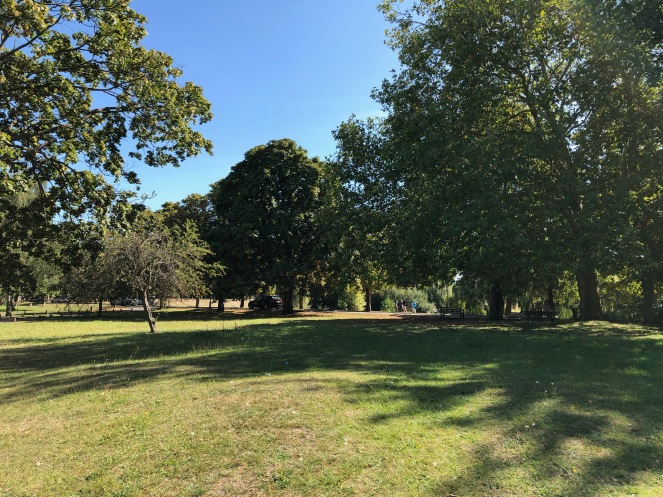

Ham Common dates back to the 17th century when a map drawn up for Charles I by Nicholas Lane in 1637 showed that the common land extended further than its current area as far as Roehampton. The northern part of Ham Common was continuous with Petersham Common, which was linked to both Richmond and Mortlake Commons.
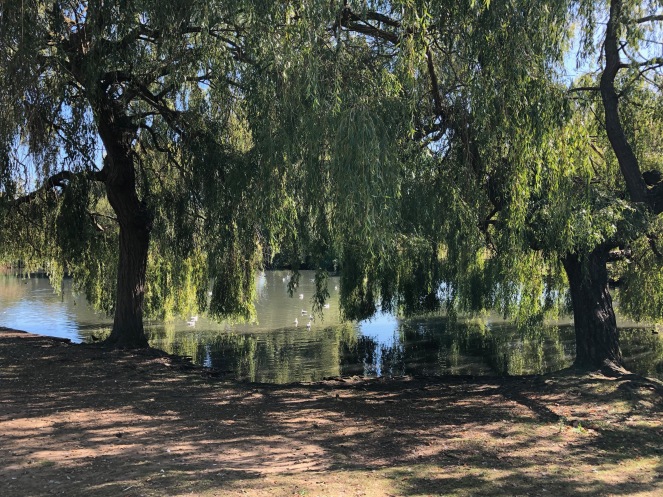
The entire area was 400 hectares (1,000 acres), of which 362 hectares (895 acres) fell within Ham’s boundaries, with 160 hectares (400 acres) of that being common land, with the rest being agricultural land in private ownership or already owned by the crown. Charles I paid compensation to the commoners of Ham and granted them a deed of gift of the remaining unenclosed common land for all time.

The park’s enclosure was one of several unpopular acts that Charles made, which contributed to unrest. Ten years later Cromwell’s Army camped on Ham Common in 1647 after the Putney Debates, which were a series of discussions between members of the New Model Army – a number of the participants being Levellers – concerning the makeup of a new constitution for Britain.
Apart from the area of the present day Common, other common land existed around the enclosed farmland of Ham. Commoners also enjoyed lammas rights on large areas of enclosed farmland adjoining the river. From the mid 17th century to the early 20th century the common land was owned by the Earl of Dysart and the Tollemache family.


The late Victorian period saw pressures on the common due to rapid expansion of buildings in London, though The Metropolitan Commons Acts 1866 to 1878 helped to preserve the land. In 1891, the Dysarts erected notices on the common warning that those who removed gravel or turf without a license would be prosecuted.


They also erected notices that trespassers on the lammas land would be prosecuted. The villagers of Ham would contest these actions, with the boards restricting the rights of commoners, which led to arrests. In 1896, the Dysarts promoted The Petersham and Ham Lands Footpaths Bill seeking to enclose the 71 hectares (176 acres) of lammas lands. The bill would be defeated though. Later that year The Metropolitan Commons (Ham) Supplemental Act 1901 established a Board of Conservators to manage Ham Common.

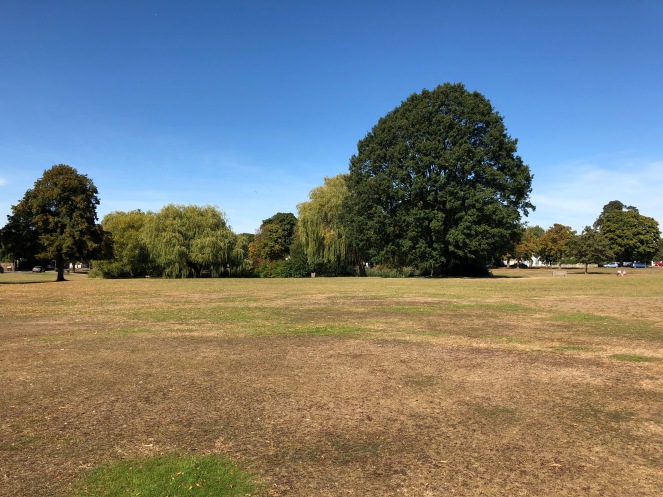
After this The Richmond, Petersham and Ham Open Spaces Act gained Royal Assent on 18 November 1902. This act would see the beginning of Ham Common falling into public ownership, as it transferred the Dysarts’ residual manorial interests in Ham Common and vested them in Ham Urban District Council. The Dysart Trustees also gave £3,000 to be invested for the upkeep of the common.
Ham Common does remind me of Barnes Green as well as Clapham Common with the road going around it and a picturesque pond at the forefront of the area. Like when I visited Kew Green, I was lucky enough to walk by a cricket match going on!
I’ll now leave Ham Common and make my way to Ham House – and as I do I walk past some cute little cottages, which gives the area a real village feel.

The walk to Ham House is rather pleasant indeed, with beautiful trees and grassland.

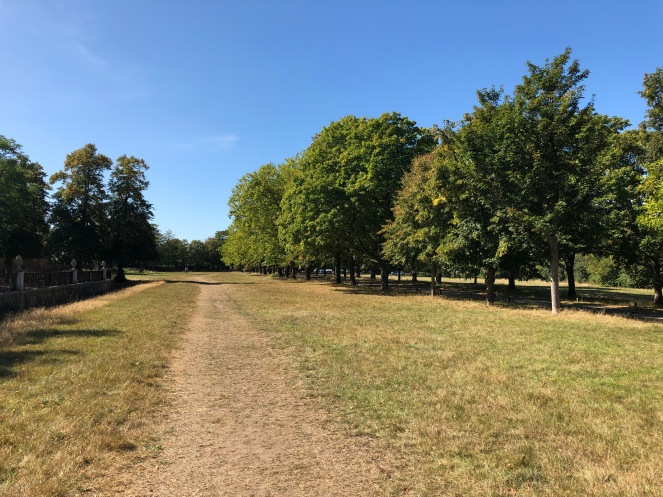
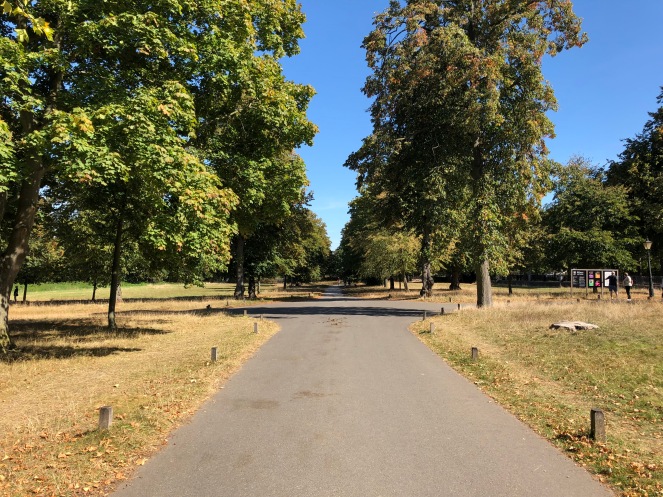

Ham House is a historical house with formal gardens located in south Richmond, about 200 metres from the River Thames. It’s claimed by the National Trust to be “unique in Europe as the most complete survival of 17th century fashion and power.”

Built in 1610, Ham House was created by William Murray and his daughter Elizabeth. William was given the lease of Ham House and its estate as a gift from the King in 1826 – and he and his daughter transformed it into its 17th century luxury and grandeur that we can enjoy today.
Between 1637 and 1639 William made a number of lavish decorative alternations to the house, which portrayed him as a man with style as well as a close friend to the King. However, in 1642 under Charles I’s the English Civil War broke out, which meant William had to fight against Parliamentarians, given that he was a royalist and close friend to the King. This meant that his wife Katherine and their young family had to hold fort at Ham House.
In 1649, Charles was tried for treason and beheaded after the loss in the war. Charles’ son came to an agreement with the Scots and was crowned Charles II of Scotland, although he failed to take back the throne of England and fled the continent. In 1653, Cromwell was installed as ‘lord protector’ of the new Commonwealth, the next 5 years of his rule would be difficult for royalist families such as the Murrays. William’s eldest daughter Elizabeth established good relations under Cromwell’s rule, which helped her steer Ham through his premiership.

Later on in 1660 when Charles II was restored to power, Ham became a prominent location for entertaining and extravagance – although this time Elizabeth Murray was the owner of the estate. In 1672, Elizabeth married the affluent Duke of Lauderdale, who himself had been a key member of King Charles II’s cabinet. Having travelled extensively the Duke and Duchess brought exotic furniture from all over the world to place within Ham, and transformed it into one of the grandest Stuart houses in England. After Elizabeth’s death, Ham House was home to her descendants within the Tollemache Family for nearly 300 years.
After a few decorative alterations during the 1740s and 1890s, the house passed to the National Trust in 1948 and I’m sure you’ll agree it’s a magficanit spectacle and such an awe-inspiring historical landmark.
I’ll now leave Ham House and head to Petersham Lodge Woods, which was once part of the landscaped grounds of the Petersham Lodge that stood near Ham House. One remarkable fact is that the trees within the wood date back to around 1750!



In 1902, Sir Max Waechter purchased the land to save it from development and gave it to the then Richmond Corporation, now Richmond Council, for preservation. Since then, it has been open to the public for everyone to enjoy and is now managed as a nature reserve and is a Site of Interest for Nature Conservation, in partnership with the Petersham Environment Trust.


I do love exploring the woodlands of London, as they have such an enchanting nature. They’re all so quiet and while you’re enclosed in all that glorious greenery and delightful trees, you feel like you’re in a bubble of beauty.




I’ll now take a detour onto the Thames Path and make the journey towards the Teddington Lock. The walk along the stretch of river takes me past the pretty riverside houses of Twickenham and Teddington, and through pleasant woodland. I certainly wouldn’t mind owning a property along the Thames! While you’re walking under the trees you definitely lose track of time as you get to bask in the glory of some of the most picturesque sights along the River Thames.




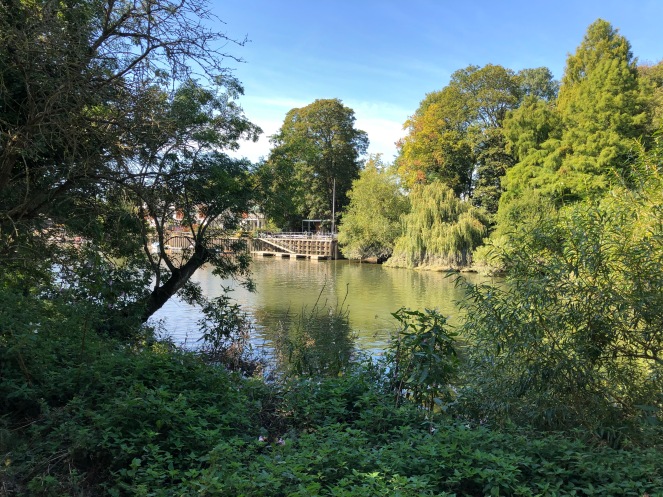





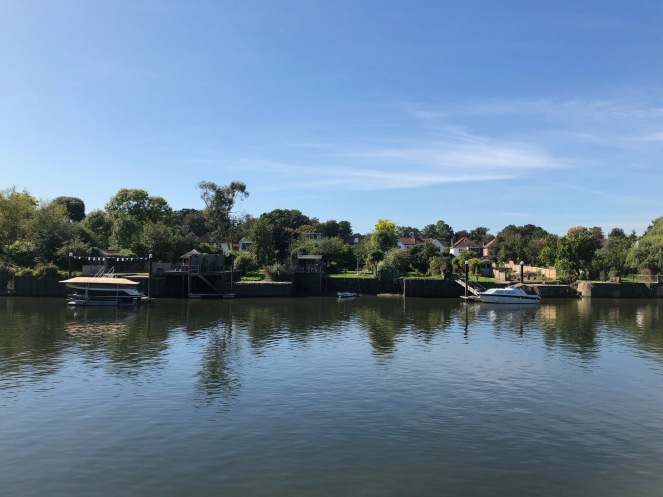
The walk along the Thames Path brings me to quite a unique sight, the Teddington Lock – which is a complex of three locks and a weir on the River Thames between Ham and Teddington. The first lock in Teddington was built in 1810 and was made of timber, although this became dilapidated and was replaced in 1857, and despite some refurbishment in 1950, it’s pretty much the lock we see today.



In 1904, the barge lock was added, which made the Teddington Lock the largest lock system on the non-tidal Thames. It has the largest weir on the Thames with 20 electrically operated gates capable of letting 12 billion gallons (54.50 billion litres) of water through a day at peak flow. The Barge Lock is also the largest lock, measuring 650 feet (198.12 metres) long and holding 1.75 million gallons (8 million litres) of water.
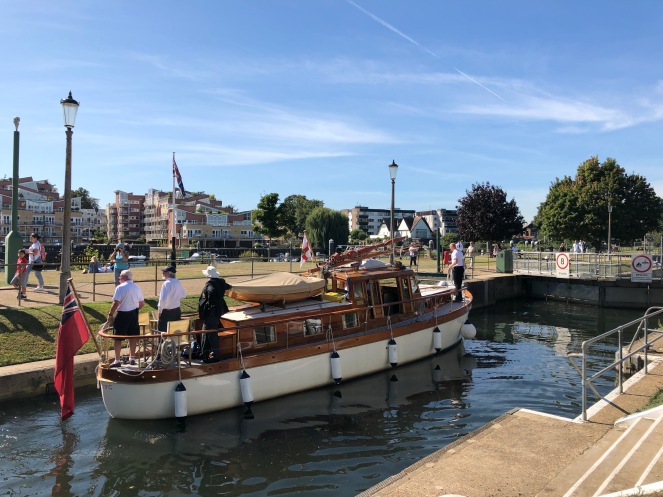

The Skiff Lock at the Teddington Lock is also the smallest lock along the River Thames, measuring a third of the size of the Barge Lock. It’s also sometimes referred to as the ‘coffin lock’ as it’s rarely used.
Here are few fun facts about the lock!
- If you were going to empty the Launch Lock by drinking the water in it, at the recommended daily rate of 2 litres of water a day, it would take just over 3,000 years to drink it dry.
- If you ran up and down the Barge lock 115 times, you would have run a marathon.
- If you wanted to fill the Barge lock up with cans of cola you would need 24 million of them.
- If you earned a pound for every litre of water the weir at Teddington let through at peak flow, you would be the world’s richest person after just 8 hours !
- You could drive 2 double decker buses side by side through the largest gates on Teddington weir.
Also did you know the famous Monty Python Fish Slapping Dance was filmed there! The Lock is also home to numerous rowing and boating clubs, including the Royal Canoe Club, Kingston Rowing Club, Walbrook Rowing Club and Tiffin School Boat Club.
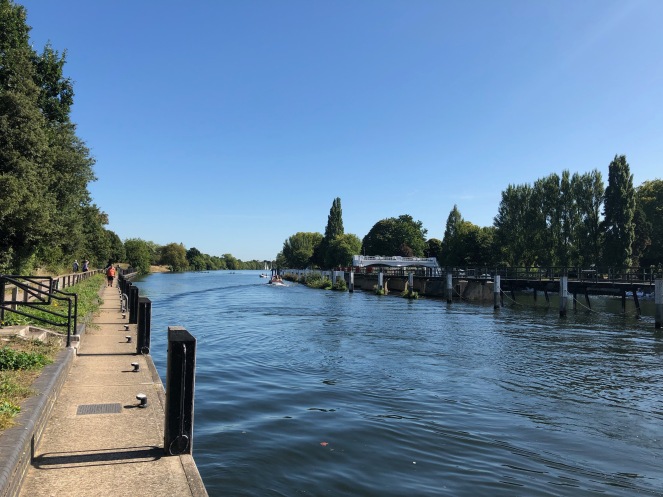


By the Lock are the Teddington Lock Footbridges, which are two separate bridges built between 1887 and 1889. They replaced the ferry which operated there. The western bridge consists of a suspension bridge crossing the weir stream and linking the island to Teddington. The eastern bridge is an iron girder bridge crossing the lock cut and linking the island to Ham on the Surrey bank. Both also have Grade II listed status to preserve them.


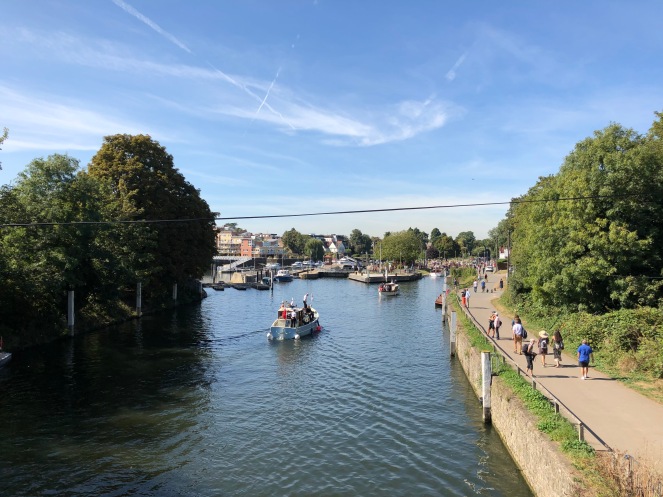




This was the first time that I’ve ever visited the Teddington Lock and I was blown away by just how unusually brilliant it was. It feels slightly like you’ve stepped into the Henley Regatta with all the boats and vibrancy of people walking along the riversides. Of all my walks it’s certainly something that I’ve not discovered before, given that all the locks I normally stroll past are quite small, whereas this is a whole complex! The bridges are also a really splendid sight to behold, there’s something about a suspension bridge, which makes it look really cool. Also there aren’t too many bridges in London that allow only pedestrians over them, so this adds to its quirkiness.
I’ll now continue my walk past the Teddington Lock along the Thames Path to Kingston! With houses and shops on my left, with the river and riverside houses on my right, the walk is once again really peaceful and pleasant. There’s something quite British about the boats going up and down the river.






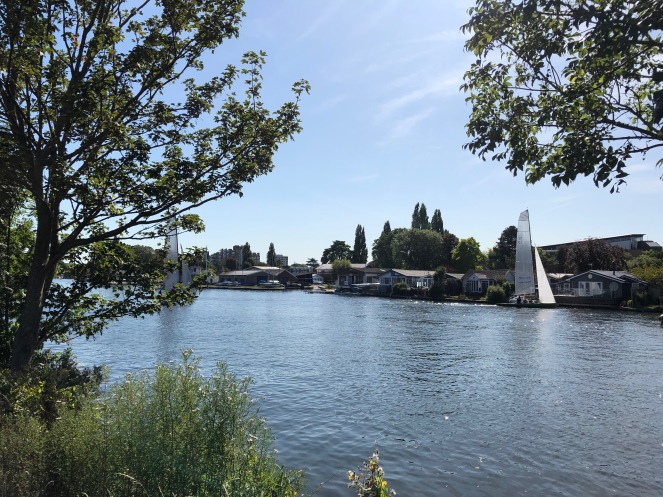

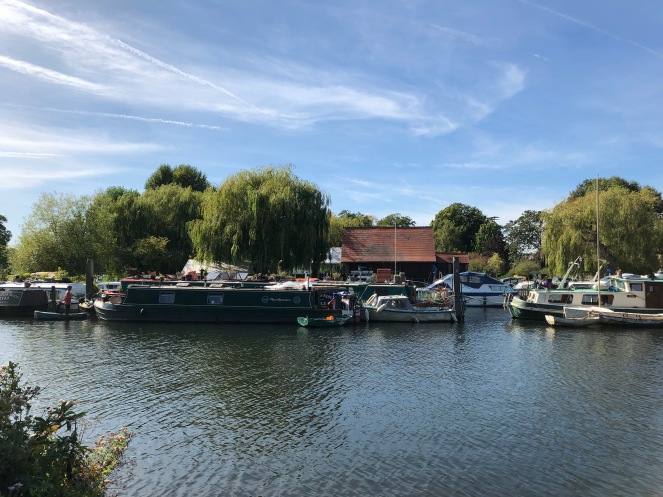

As you walk to Kingston you get to the Kingston Railway Bridge, which was originally a cast-iron bridge designed by J.E. Errington in 1863. This was replaced with the bridge we see today, which was designed by J.W. Jacomb Hood and opened in 1907. I’m not sure about you, but I think that the Kingston Railway Bridge might get the award for ‘less aesthetically pleasing’ bridge in London!


If Kingston Railway Bridge is a little on the ugly side, Kingston Bridge wins the beauty contest! Until Putney Bridge was opened in 1729, Kingston Bridge was the only crossing of the river between London Bridge and Staines Bridge. According to 16th century antiquarian John Leland, the bridge existed in the centuries when Anglo-Saxon England existed. However, it’s also claimed that the first Kingston Bridge was constructed in the 1190s.
The portland stone bridge that we see today was designed by Edward Lapidge and opened in 1828. The stunning bridge does resemble that of Richmond Bridge and both add real character and beauty to the riverside of London.



I’m now going to hop over Kingston Bridge to head towards Hampton Court Park. To do that I’m going to join the Barge Walk, which again gives you many amazing views along the River Thames.


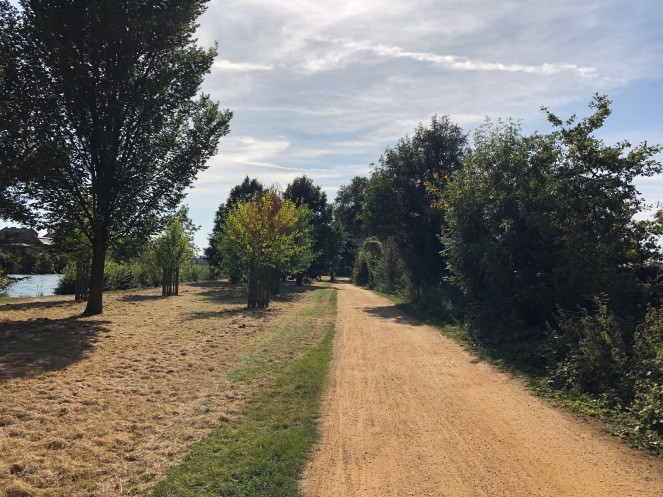
Managed by the Historic Royal Palaces, Hampton Court Park or sometimes referred to as Home Park, is a walled deer park of around 280 hectares (750 acres) and has been open to the public since 1894. It was documented that Cardinal Thomas Wolsey enclosed 809 hectares (2,000 acres) to form the park as well as Bushy Park in order to reconstruct it into an exceptionally grand house on the former manor house of Hampton. It would form what became before his death Hampton Court Palace, taken over by Henry VIII. The King was an avid hunter and had the park used for breeding rabbits and/or hares, pheasants and partridges.
The park is famous for hosting the annual Hampton Court Flower Show within 10 hectares (25 acres) of the park’s grounds. Organised by the Royal Horticultural Society, the flower show began in 1990.
Walking through Hampton Court Park is rather pleasant and does remind me of my walk around Richmond Park. It’s acres and acres of tranquility where you literally can’t hear anything apart from the birds singing, there’s an eerily silence throughout my walk. The trees all lined up is quite satisfying and the park looks untouched, as if no one has really ever walked through it. If you love your trees, this is the park for you, as it’s full of them. With every turn you come across another vast area of parkland. No park is complete without a pond area and Hampton Court Park offers a splendid one, which provides the perfect photo opportunity with delightful reflections.
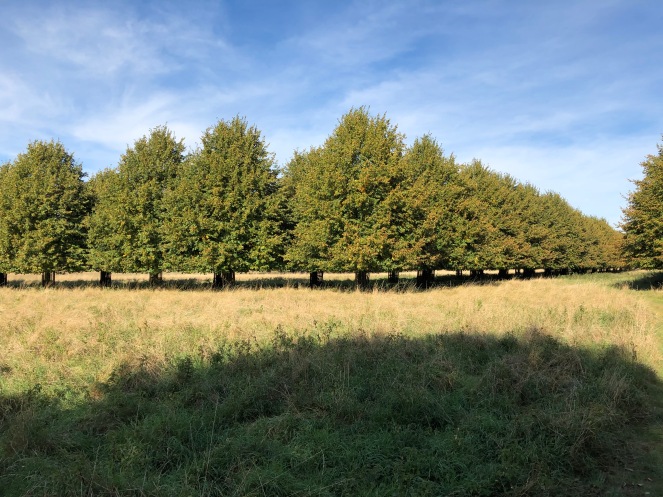

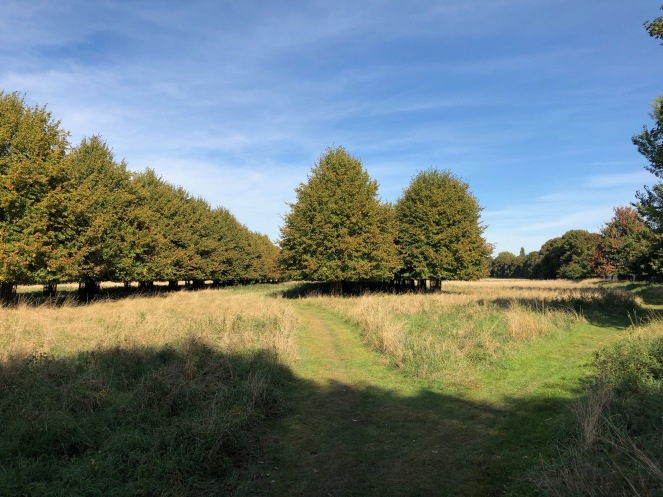




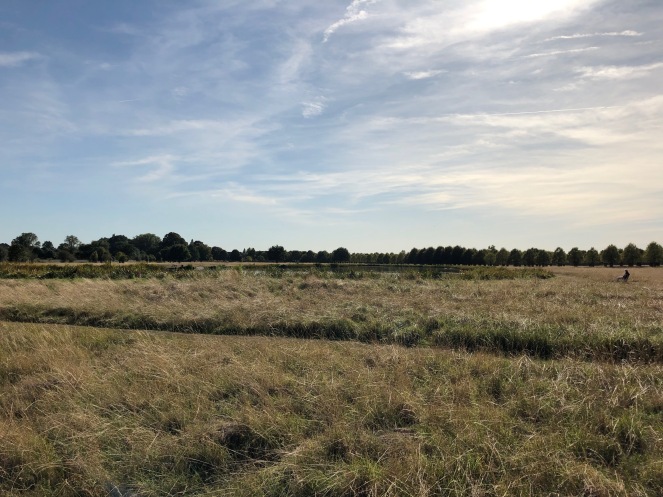








Like with Richmond Park’s deers, Hampton Court Park has loads! They’re really majestic creatures and you can get up and close to them, you feel like a wildlife presenter!


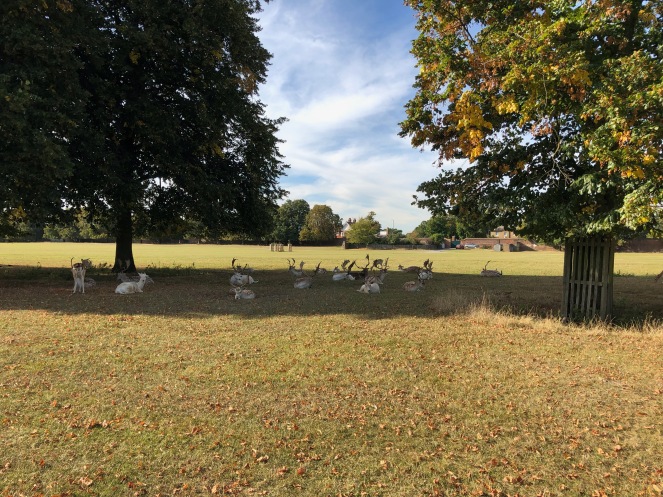
One of the most spectacular sights in the park is The Long Water, which flows gently in the park from the back of Hampton Court Palace. This beautiful canal was commissioned by Charles II in preparation for the arrival of his bride, Catherine of Braganza.
I have to say seeing The Long Water was breathtaking and it’s definitely in my top five sights that I’ve seen on my walks. It’s one of many reasons I love doing my walking blog, as I get to enjoy amazing views like this. Had I not been walking around London along the Thames, I might not have been able to see it. The trees delightfully lined up and reflecting in the water only adds to the magnificent splendour of it.


I’ll now depart Hampton Court Park and make my way to Bushy Park, which at 445 hectares (1,100 acres) makes it the second largest of London’s Royal Parks after Richmond Park.
Bushy Park dates back to at least 4,000 years ago, with evidence that the area was used in the medieval period for agricultural purposes. When Henry VIII took over Hampton Court Palace from Cardinal Thomas Wolsey in 1529, the King named three parks that make up modern-day Bushy Park and a small area beside: Hare Warren, Middle Park and Bushy Park.
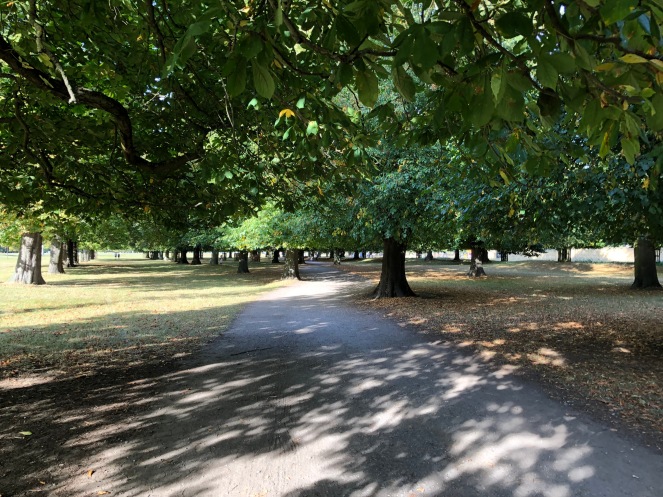


His successors added the Longford River, a 19km canal built on the orders of Charles I of England to provide water to Hampton Court. From the mid-19th century until World War II, Londoners came there to celebrate Chestnut Sunday to see the abundant blossoming of the trees along Chestnut Avenue.
During World War I, Bushy Park housed the King’s Canadian Hospital, and between the wars it hosted a camp for undernourished children. Also during World War II, General Dwight D. Eisenhower planned the D-Day landings from Supreme Headquarters Allied Expeditionary Force (SHAEF) at Camp Griffiss in the Park.



It’s quite incredible that two iconic parks, Bushy Park and Hampton Court Park, are so close together! I feel I’m getting spoilt on this walk with all this marvellous parkland that I’ve seen.




At the forefront Bushy Park is the marble and stone Diana Fountain, which is surrounded by bronzes of four boys, four water nymphs and four shells. The original fountain was requested by King Charles I for Queen Maria’s garden at Somerset House in 1637. The fountain was moved to the Privy Garden of Hampton Court in 1656. Designed by Sir Christopher Wren, it was moved to its current location in 1713.
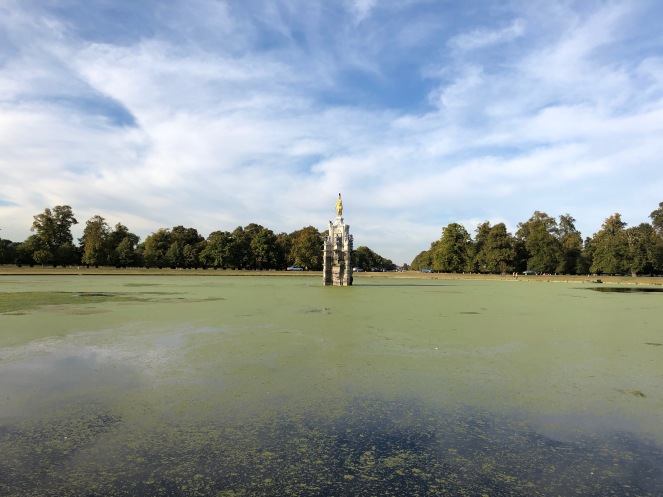

My walk now takes me to my penultimate destination today, Hampton Court Palace. The original Tudor palace was created by Cardinal Thomas Wolsey in the early 16th century, but when it attracted the attention of Henry VIII, he brought all of his six wives there. By the 1530s, Henry VIII’s Hampton Court was a palace, a hotel, a theatre and a vast leisure complex. Henry’s third queen Jane Seymour died giving birth to Edward, later Edward VI. Legend has it that her ghost appears on the anniversary of her death. Also Henry’s fifth wife, Catherine Howard was arrested there and later executed at the Tower for adultery and treason.
One of the prominent features of the palace under Henry VIII was its kitchen! The Great Kitchen was built late in 1400s, which had to serve up to 800 courtiers – that’s a staggering 1,600 meals a day!
In 1603, William Shakespeare’s ‘King’s Men’ first performed Hamlet and Macbeth for the new Stuart King James I. James was also responsible for organising the 1604 Hampton Court Conference that resulted in the publication of the King James Bible in 1611 – the Authorised Version of the Bible in English.
-

Hampton Court Palace
His son Charles I used the palace to house much of his astonishing art collection, including Mantegna’s ‘Triumph of Caesar’ paintings. It would also become a temporary prison! In 1647, he found himself under house arrest after his defeat in the Civil War. In an attempt to flee Oliver Cromwell’s Parliamentarians, the King escaped through the Privy Garden. Charles was later recaptured and executed in 1649. During the Commonwealth (1649-60) Cromwell saved the palace from destruction by making it his home. Sir Christopher Wren was commissioned to build an elegant new baroque palace when William III and Mary II took the throne in 1689.
Later, Georgian kings and princes occupied the splendid interiors. When the royals left in 1737, impoverished ‘grace and favour’ aristocrats moved in. Queen Victoria opened the palace to the public in 1838 and it has remained a magnet for millions of visitors, drawn to the grandeur, the ghosts and the fabulous art collection.

It’s time to leave the magnificent palace and rejoin the Thames Path, but only for a few minutes as I reach the final stop on my walk, Hampton Court Bridge.

The most upstream bridge that crosses the Thames, Hampton Court Bridge has had four bridges on its site. The first of these was constructed by Samuel Stevens and Benjamin Ludgator, opening in 1753.

However, in 1778 it was replaced with a more sturdy eleven-arch wooden bridge, although in 1840 it had become dilapidated. This prompted a third bridge to be built on the site in 1865, which was designed by E.T. Murray and commissioned by the bridge’s owner Thomas Allen. This new bridge consisted of wrought iron lattice girders, although it was heavily criticised, so much so it was called “inartistic” by one Historic Gazetteer. It was however very lucrative for Thomas Allen, earning him over £3,000 annually in tolls, until it was bought out in 1876 by a joint committee of the Hampton and Molesey Local Boards and the Corporation of London.

The modern bridge we see today opened in 1933 and was designed by W.P. Robinson and Sir Edward Lutyens to reflect the style of parts of Hampton Court Palace. Like with many of London’s bridges, the colour and design are quite striking and you can certainly see the royal influence on it.
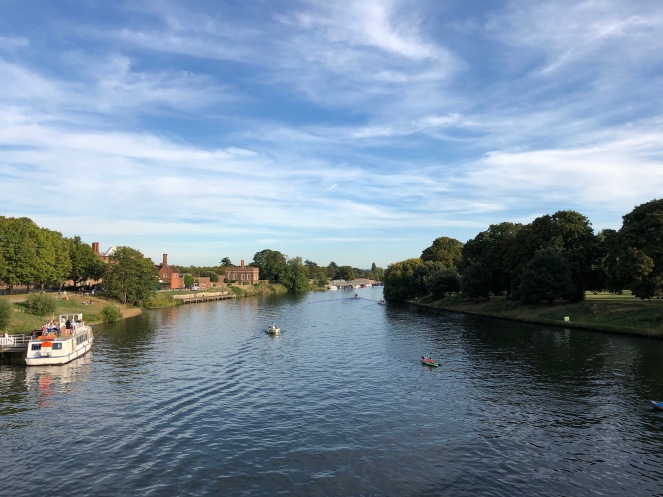
Well that’s all from my walk where I’ve discovered the best sights along the Thames, including Ham, Teddington, Kingston and Hampton. I’ve also explored how the reign of Henry VIII had such a profound and lasting legacy on this part of London. This was one of the most exciting walks I’ve done and I hope you’ve enjoyed joining me on it. If you have any memories or thoughts on London, please let me know in the comments section below!
Thanks for reading and in the meantime you can follow all my walks on Facebook, Twitter and Instagram, and don’t forget to sign up to my blog too so you don’t miss a post! Also why not have a read of my other walks which explore all over London, from north to south, to west to east via central, there’s something there for you! 🙂 Here are the links to them all below for you!
King’s Cross to Hampstead Heath
Leadenhall Market to Old Spitalfields Market
St Paul’s Cathedral to Moorgate
Mile End Park to London Fields
Hyde Park Corner to Italian Gardens
Clapham Common to The Albert Bridge
Grosvenor Gardens to Knightsbridge
Holland Park to Meanwhile Gardens
Hackney Downs to Springfield Park
Ravenscourt Park to Wormwood Scrubs
Covent Garden to Southwark Bridge
Putney Bridge to Barnes Common
Westminster Abbey to Vauxhall Bridge
Crystal Palace Park to Dulwich Wood
Clapham Junction to Battersea Bridge
Norbury Park to Tooting Commons
Lesnes Abbey Woods to the Thames Barrier
Richmond Green to Wimbledon Common
Gladstone Park to Fryent Country Park
Whitehall to Piccadilly Circus
Tower of London to the Limehouse Basin
Sources:
All photos taken by London Wlogger © Copyright 2019
Information about Petersham Lodge Woods
Information about Teddington Lock and Footbridges
Information about Kingston Railway Bridge and Kingston Bridge
Information about Hampton Court Park

Lovely part of the world! This was a wander down memory lane for me much helped by your gorgeous photos.
LikeLiked by 1 person
Thank you so much Sheree, glad I could bring you so close to the areas 😊
LikeLiked by 1 person
Another fabulous walk. We spent a wonderful day exploring Hampton Court Palace and its surrounds. I love the beautiful gates that open onto the footpath on the river.
LikeLiked by 1 person
Wow marvellous, it’s truly a spectacular place to explore 😃
LikeLike
What an interesting walk. I like the Palace and would like to explore the adjacent areas.
LikeLiked by 1 person
It’s one of the most picturesque and historical eye openers that I’ve done in London, so beautiful! 😊
LikeLiked by 1 person
I am amazed that you can walk to Hampton Court Palace from London. We lived in Reigate and drove there a number of times, but it never felt close to London to me. This was an amazing walk, and I enjoyed going along with you.
LikeLiked by 1 person
Aww thanks so much, Anne! It’s quite a long walk along the Thames Path, but definitely worth every part of it as you see so much beauty 😃
LikeLiked by 1 person
Great photos and info. You both stirred up memories and evoked a wish to explore the river path which I’m not familiar with.
LikeLiked by 1 person
That’s wonderful to hear Claire, I do love sharing new parts of London with people and bringing back lovely memories 😊
LikeLike